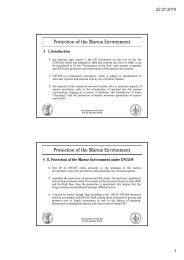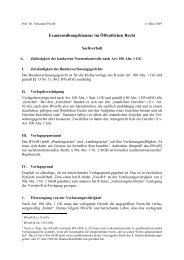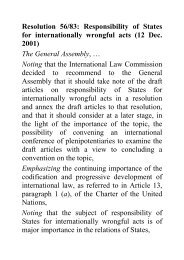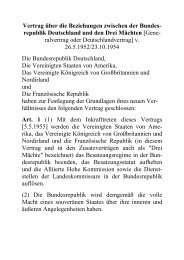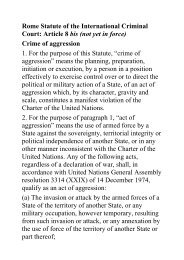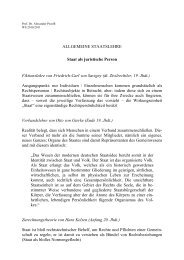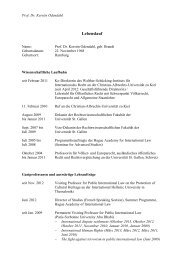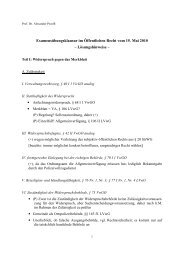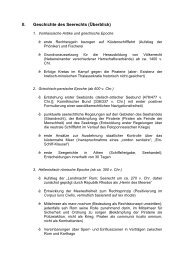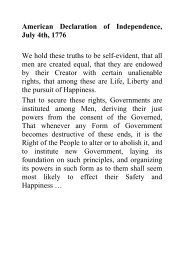Protocol I Additional to the Geneva Conventions
Protocol I Additional to the Geneva Conventions
Protocol I Additional to the Geneva Conventions
Create successful ePaper yourself
Turn your PDF publications into a flip-book with our unique Google optimized e-Paper software.
<strong>Pro<strong>to</strong>col</strong> <strong>Additional</strong> <strong>to</strong> <strong>the</strong> <strong>Geneva</strong> <strong>Conventions</strong><br />
of 12 August 1949, and relating <strong>to</strong> <strong>the</strong><br />
Protection of Victims of International Armed<br />
Conflicts (<strong>Pro<strong>to</strong>col</strong> 1) of 8 June 1977<br />
Article 43.-Armed forces<br />
1. The armed forces of a Party <strong>to</strong> a conflict consist<br />
of all organized armed forces, groups and units<br />
which are under a command responsible <strong>to</strong> that<br />
Party for <strong>the</strong> conduct of its subordinates, even if<br />
that Party is represented by a government or an<br />
authority not recognized by an adverse Party. Such<br />
armed forces shall be subject <strong>to</strong> an internal<br />
disciplinary system which, inter alia, shall enforce<br />
compliance with <strong>the</strong> rules of international law<br />
applicable in armed conflict.<br />
2. Members of <strong>the</strong> armed forces of a Party <strong>to</strong> a<br />
conflict (o<strong>the</strong>r than medical personnel and<br />
chaplains covered by Article 33 of <strong>the</strong> Third<br />
Convention) are combatants, that is <strong>to</strong> say, <strong>the</strong>y<br />
have <strong>the</strong> right <strong>to</strong> participate directly in hostilities.
Article 44.-Combatants and prisoners of war<br />
1. Any combatant, as defined in Article 43, who falls<br />
in<strong>to</strong> <strong>the</strong> power of an adverse Party shall be a prisoner of<br />
war. …<br />
3. In order <strong>to</strong> promote <strong>the</strong> protection of <strong>the</strong> civilian<br />
population from <strong>the</strong> effects of hostilities, combatants are<br />
obliged <strong>to</strong> distinguish <strong>the</strong>mselves from <strong>the</strong> civilian<br />
population while <strong>the</strong>y are engaged in an attack or in a<br />
military operation prepara<strong>to</strong>ry <strong>to</strong> an attack.<br />
Recognizing, however, that <strong>the</strong>re are situations in armed<br />
conflicts where, owing <strong>to</strong> <strong>the</strong> nature of <strong>the</strong> hostilities an<br />
armed combatant cannot so distinguish himself, he shall<br />
retain his status as a combatant, provided that, in such<br />
situations, he carries his arms openly …
Article 48.-Basic rule<br />
In order <strong>to</strong> ensure respect for and protection of <strong>the</strong><br />
civilian population and civilian objects, <strong>the</strong> Parties<br />
<strong>to</strong> <strong>the</strong> conflict shall at all times distinguish between<br />
<strong>the</strong> civilian population and combatants and<br />
between civilian objects and military objectives<br />
and accordingly shall direct <strong>the</strong>ir operations only<br />
against military objectives.<br />
Article 50.-Definition of civilians and civilian<br />
population<br />
1. A civilian is any person who does not belong <strong>to</strong><br />
one of <strong>the</strong> categories of persons referred <strong>to</strong> in<br />
Article 4 A (1), (2), (3) and (6) of <strong>the</strong> Third<br />
Convention and in Article 43 of this <strong>Pro<strong>to</strong>col</strong>. In<br />
case of doubt whe<strong>the</strong>r a person is a civilian, that<br />
person shall be considered <strong>to</strong> be a civilian.<br />
2. The civilian population comprises all persons<br />
who are civilians.<br />
3. The presence within <strong>the</strong> civilian population of<br />
individuals who do not come within <strong>the</strong> definition<br />
of civilians does not deprive <strong>the</strong> population of its<br />
civilian character.
Article 51.-Protection of <strong>the</strong> civilian population<br />
1. The civilian population and individual civilians<br />
shall enjoy general protection against dangers<br />
arising from military operations. To give effect <strong>to</strong><br />
this protection, <strong>the</strong> following rules, which are<br />
additional <strong>to</strong> o<strong>the</strong>r applicable rules of international<br />
law, shall be observed in circumstances.<br />
2. The civilian population as such, as well as<br />
individual civilians, shall not be <strong>the</strong> object of<br />
attack. Acts or threats of violence <strong>the</strong> primary<br />
purpose of which is <strong>to</strong> spread terror among <strong>the</strong><br />
civilian population are prohibited.<br />
3. Civilians shall enjoy <strong>the</strong> protection afforded by<br />
this Section, unless and for such time as <strong>the</strong>y take a<br />
direct part in hostilities. …



